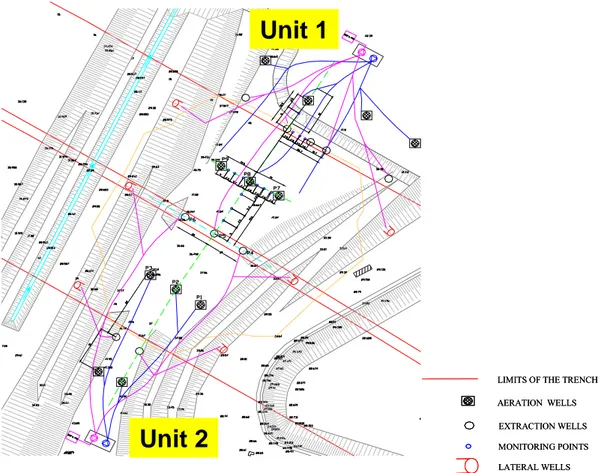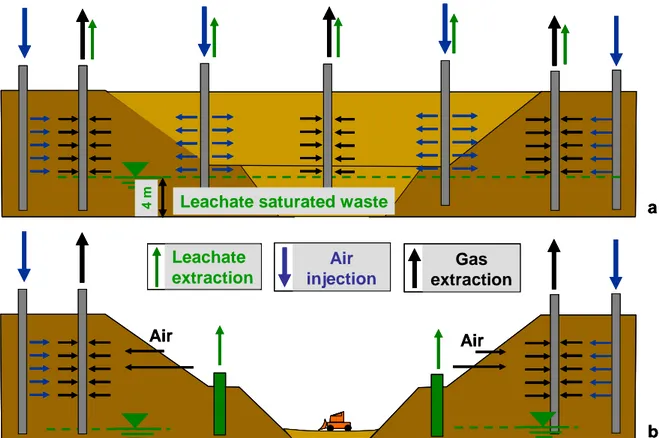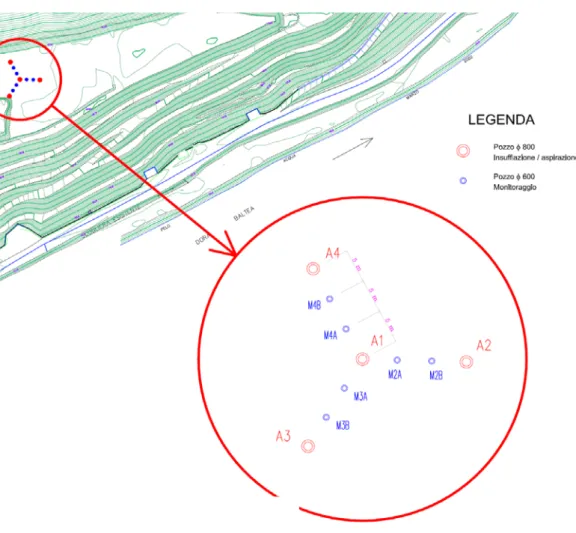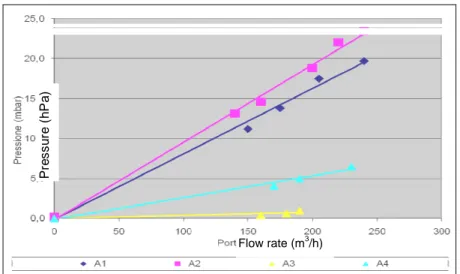43
LANDFILL IN-SITU AERATION
PROCESS AND TECHNOLOGY
Roberto Raga
Raffaello Cossu
University of Padova, Italy
ABSTRACT
In situ aeration of landfills enables the aerobic degradation process to develop in the landfill with the subsequent reduction of the emission potential in a much shorter time than under anaerobic conditions. Moreover, in situ aeration is particularly recommended as landfill pre-treatment before landfill mining activities. Preliminary investigations are required, to be carried out on the landfill by means of a pilot scale plant, in order to acquire the relevant information for the design of a full scale in situ aeration plant. Some results are presented below, obtained during preliminary investigations carried out on a municipal solid waste landfill in a mountain area in northern Italy, aimed at the application of in situ aeration in view of landfill mining.
KEYWORDS
Old landfills, In situ aeration, Landfill Mining 1 INTRODUCTION
It is very well known that long term emissions from landfills can cause harmful effects in the surrounding area for centuries (Belevi and Baccini, 1997, Kruempelbeck and Ehrig, 1999).
By means of in situ aeration, the conditions in the landfill can be converted from anaerobic into aerobic with the subsequent acceleration of stabilization processes of the biodegradable fraction, with the aim of a faster reduction of the residual potential emissions and of the related environmental impact (Cossu et al., 2007, Ritzkowski et al., 2006). Leachate extraction carried out from the aeration wells enable faster biological stabilization of waste due to the enhancement of air diffusion in the landfill body and provides enhanced mechanical properties of the landfill at the same time. For these reasons, in situ aeration can also be considered the best option for landfill pre-treatment before landfill mining activities, in order to establish proper conditions (minimization of the emissions of methane and other trace compounds, mechanical stability of the landfill) for the excavation works.
In the year 2002 the first full scale in situ aeration of a landfill was implemented in Italy in the landfill of Modena, as the preliminary step of a landfill mining project aimed at the excavation of a trench in the landfill (removal of 200.000 m3 of waste) for the construction of the high velocity railway line from Milan to Bologna (Cossu et al., 2003). In order to facilitate excavation and further disposal of the extracted waste, suitable measures were defined. Among others, the aerobic in situ stabilisation of the area coupled with leachate extraction took place before the start of the excavation. A
specific technology was implemented and then patented by Spinoff as Airflow®, that foresees the low pressure air injection and process gas extraction from the landfill by means of purpose made wells.
An Airflow® plant comprises blowers for air injection and gas extraction, aeration and monitoring wells, monitoring and control devices (flow meters and automatic valves for flow adjustment; facilities for gas and leachate sampling and analysis as well as temperature monitoring), an automatic control unit equipped with gas analyzer and a PC-PLC system, an exhaust air treatment system. The air extracted is conveyed to a biofiltration system before release into the atmosphere. Every aeration well is equipped with a pneumatic pump for leachate extraction in order to keep the leachate table low inside the landfill and thus increasing the volume of waste available for air diffusion. The management phase of the plant foresees the implementation of a monitoring plan for analyses on waste, leachate and gas; monitoring of temperature and pressure and leachate table in the landfill body. The technology has been implemented in order to operate under adequate safety conditions: a patented safety system guarantees that no potentially explosive mixtures of methane and air are extracted form the landfill.
The full scale in-situ aeration plant in Modena landfill comprised 12 air injection wells, 16 gas extractions wells and 13 monitoring wells as shown in Figure 1, as well as two biofilters for biogas treatment and a leachate extraction system. The installation comprised two independent units (Unit 1 and 2 in Figure 1) in order to enable continuous operation of the plant during the excavation of the trench for the railway line between the two units (Figure 2): a low depression was maintained in the area beside the trench with atmospheric air flowing from the excavation area through the trench slopes into the waste, thus limiting biogas emissions from the rest of the landfill into the working area. The transversal section of the area during the preliminary in situ aeration (a) and the excavation works (b) is shown in Figure 3, where the additional leachate extraction wells used in order to enhance leachate removal during the excavation are visible.
The measures taken ensured an increased biological stabilisation of deposited waste thus safer conditions during excavation due to the reduced biogas production potential of the waste. Moreover, the increased biological stability of the waste provided better conditions for handling and treatment after the excavation.
Proper investigations and preliminary tests are necessary to obtain all the necessary information to carry out the design of an in situ aeration plant and an effective monitoring of the stabilization process during the operation. Among others, the radius of influence of air injection and gas extraction wells and the pressure field in the landfill body during the aeration process have to be evaluated by means of pilot scale tests. Other preliminary investigations are related to waste characterization (i.e. biological stabilization) and the evaluation of mass balance of the organic carbon in the landfill for the estimation the expected conversion of organic carbon into CO2 during the in situ aeration, for comparison with what expected in the traditional anaerobic landfill.
In the paper some results of preliminary in situ aeration tests carried out in a landfill in northern Italy where landfill mining is foreseen are presented.
45
Unit 1
Unit 2
Unit 1
Unit 2
LIMITS OF THE TRENCH AERATION WELLS EXTRACTION WELLS LATERAL WELLS MONITORING POINTS LIMITS OF THE TRENCH AERATION WELLS EXTRACTION WELLS LATERAL WELLS MONITORING POINTS
Figure 1. Aerobic stabilization of the Landfill of Modena. Lay-out of air injection and biogas extraction wells. Unit 1 and unit 2 are independent in order to enable continuous operation of the plant during the excavation of the trench between the two units.
LIMITS OF THE TRENCH
AERATION WELLS
EXTRACTION WELLS
FIRST EXCAVATION PHASE LATERAL WELLS
SECOND EXCAVATION PHASE
THIRD EXCAVATION PHASE MONITORING POINTS LIMITS OF THE TRENCH
AERATION WELLS
EXTRACTION WELLS
FIRST EXCAVATION PHASE LATERAL WELLS
SECOND EXCAVATION PHASE
THIRD EXCAVATION PHASE MONITORING POINTS
4 m Leachate saturated waste
Gas extraction Leachate extraction Air injection a b Air Air
4 m Leachate saturated waste
Gas extraction Leachate extraction Air injection a b
4 m Leachate saturated waste
Gas extraction Leachate extraction Air injection a b Air Air
Figure 3. Transversal section of the area during the in situ aeration (a) and during the excavation works (b).
2. IN SITU AERATION TESTS
The in situ aeration tests were carried out in order to evaluate the feasibility of the application of in situ aeration in the landfill; moreover, relevant parameters for the design of the full scale plant were ascertained, the radius of influence of air injection and gas extraction wells and the pressure field in the landfill body during the aeration process among others.
In the paper some results of preliminary in situ aeration tests carried out in a landfill in northern Italy where landfill mining is foreseen are presented.
2.1 Description of the field tests
The field test have been carried out in a pilot plant with 4 purposely built air injection wells and 6 monitoring wells, each one of them comprising slotted pipes at various depths in the landfill. A sketch of the field test site is provided in Figure 4. A mobile unit equipped with blowers, air flow meters, manometers as well as a power supply unit was used for the test (Figure 5). Prior to the aeration test landfill monitoring has been carried out for:
- leachate head; - biogas composition;
47 - temperature in the landfill body;
- efficiency of the air injection wells.
The tests for the evaluation of the efficiency of the air injection wells provided the data for making the pressure-flow rate diagram shown in Figure 6, where the effects of the heterogeneity of the waste deposited and the subsequent different response to air injection in different points in the landfill are clear.
Due to the high leachate head in the landfill some of the slotted pipes in the monitoring wells resulted to be positioned in the saturated part of the landfill and therefore they resulted useless for collecting biogas samples or for pressure monitoring.
Moreover, the presence of huge quantities of sewage sludge throughout the landfill caused the filling of some aeration wells up to unexpected levels. For this reason, proper pneumatic devices for the extraction of the sludge (as well as of the leachate) from the wells were designed and installed. The extraction of leachate and sludge from the aeration wells was successful and enabled better conditions to establish for the aeration as well as for the landfill mining activities foreseen in the landfill.
Figure 4. Location of the field tests in the landfill with a sketch of the position of the aeration wells A1÷A4 and of the monitoring wells (Mij).
Aeration tests involved air injection from one injection well at the time and monitoring of pressure and biogas composition in all other wells. Each test lasted approximately 6
hours and it was enough to reach significant O2 concentrations in most of the investigated part of the landfill (see an example in Figure 7).
The results showed that air distribution in the landfill body was satisfactory during the tests, although different behaviour was recorded during each of the tests, confirming the heterogeneity as well as the anisotropy of the landfill. The radius of influence of the wells installed was estimated in the range 10 – 15 m.
Figure 5. The air injection/gas extraction mobile unit used for the tests
49
Figure 6. Example of pressure-flow rate diagram during air injection tests in wells A1 ÷ A4.
Figure 7: O2 concentration (% vol.) in the monitoring wells 11 m deep in the landfill and in wells A1, A2 and A4 after a 6-hour air injection test from well A3.
3. CONCLUSIONS
Landfill aeration can be successfully used in the investigated landfill and would provide the conditions for the acceleration of biodegradation processes and the subsequent abatement of the long term pollution potential of the landfill, provided that proper measures are foreseen for lowering the leachate head in the landfill and for the removal of the sludge from the aeration wells.
O
2 Flow rate (m3/h) P re ssu re ( h P a )
At the same time the full scale in situ aeration would provide the conditions required for the foreseen landfill mining activities, with the minimization of biogas emissions expected in the excavation area. The enhancement of the biological stability of the waste and the reduction of the moisture content will provide further advantages during the handling of the excavated material and the subsequent treatment processes.
The tests carried out provided the following information (among others):
- O2 distribution in the landfill body was satisfactory during the tests, although different behaviour was recorded in the different points confirming the heterogeneity as well as the anisotropy of the landfill. The applicability of the Airflow technology for landfill remediation and as a pre-treatment before landfill mining was ascertained;
- the radius of influence of the wells installed was estimated in the range of 10 to 15 meters. These data will be used for the design of the full scale plant together with the other information obtained during the tests;
- leachate extraction from aeration wells proved to be successful despite the presence, in various spots in the landfill body, of a considerable amount of sewage sludge that migrated into the aeration wells. The system of pneumatic devices installed for sludge and leachate extraction was very effective and the tests provided useful indication for further improvement for the full scale application.
REFERENCES
Belevi H., Baccini P. (1997). Long-Term Leachate Emission from Municipal Solid Waste Landfills. In: Landfilling of Waste: Leachate. Edited by T.H. Christensen, R. Cossu, R. Stegmann, published by E & FN Spon, 1997, pp. 431-439.
Cossu R., Raga R., Rossetti D. (2003). Full Scale Application of in Situ Aerobic Stabilization of old Landfills. Proceedings Sardinia 2003, Ninth International Waste Management and Landfill Symposium. S. Margherita di Pula, Cagliari.
Cossu R., S. Cestaro, R. Raga, D. Rossetti, A. Costa, 2007. L’aerazione in situ per il risanamento delle discariche di RSU. Rifiuti Solidi, Vol. XXI, n. 4, Luglio/Agosto 2007. CIPA Editore, Milano. ISSN: 0394-5391
Kruempelbeck I., Ehrig H.-J., 1999. Long-Term behaviour of Municipal Solid Waste Landfills in Germany. In: Proceedings Sardinia 99, Seventh International Waste Management and Landfill Symposium. S. Margherita di Pula, Cagliari.
Ritzkowski M., Heyer K.-U., Stegmann R. (2006). Fundamental processes and implications during in situ aeration of old landfills. Waste Management. vol. 26 (2006), pp. 356-372.



